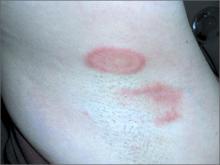The FP diagnosed tinea corporis by recognizing the pattern of the concentric rings, which have a high specificity for tinea infections. To confirm the diagnosis, the FP performed a scraping of the area and found branching septate hyphae. This is the microscopic appearance of dermatophytes, which come in 3 genera: microsporum, epidermophyton, and trichophyton. There are approximately 40 species in these 3 genera and these fungi cause tinea pedis and manus, tinea capitis, tinea corporis, tinea cruris, tinea faciei, and onychomycosis.
Potassium hydroxide (KOH) test characteristics (without fungal stains) have a sensitivity of 77% to 88% and a specificity of 62% to 95%.1 The sensitivity and specificity is higher with fungal stains and the experience of the person performing the test. Fungal infections of the skin and mucous membranes are ubiquitous and common. There are many types of fungus that grow on humans, but they all share a predilection for warm and moist areas. Consequently, hot and humid climates promote fungal infections. The FP also asked to check the patient’s feet and found a mild case of tinea pedis between the 4th and 5th toes bilaterally.
The FP explained the diagnoses to the patient and recommended that she purchase topical terbinafine over the counter. He explained that there are no better topical antifungals by prescription and that she could find this medicine in the athlete’s foot area of any pharmacy or large grocery store. He told her that she did not have to stop running and that anyone can get a fungal infection. The FP recommended that the patient use the cream for at least one week after clinical clearance and to do her best to keep her feet and axillae dry to avoid new fungal infections.
1. Thomas B. Clear choices in managing epidermal tinea infections. J Fam Pract. 2003;52:850-862.
Photos and text for Photo Rounds Friday courtesy of Richard P. Usatine, MD. This case was adapted from: Usatine R. Fungal overview. In: Usatine R, Smith M, Mayeaux EJ, et al, eds. Color Atlas of Family Medicine. 2nd ed. New York, NY: McGraw-Hill; 2013:771-776.
To learn more about the Color Atlas of Family Medicine, see: www.amazon.com/Color-Family-Medicine-Richard-Usatine/dp/0071769641/
You can now get the second edition of the Color Atlas of Family Medicine as an app by clicking on this link: usatinemedia.com


